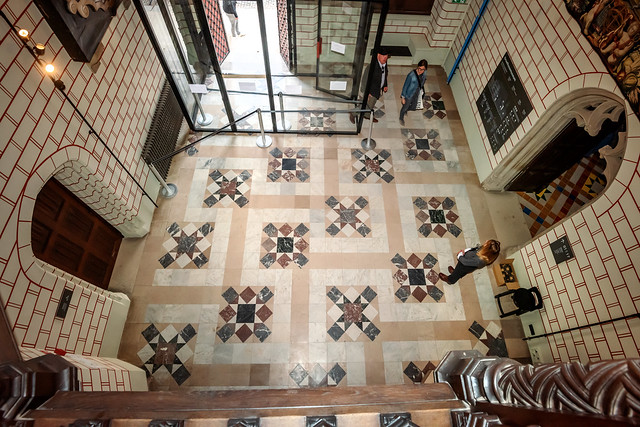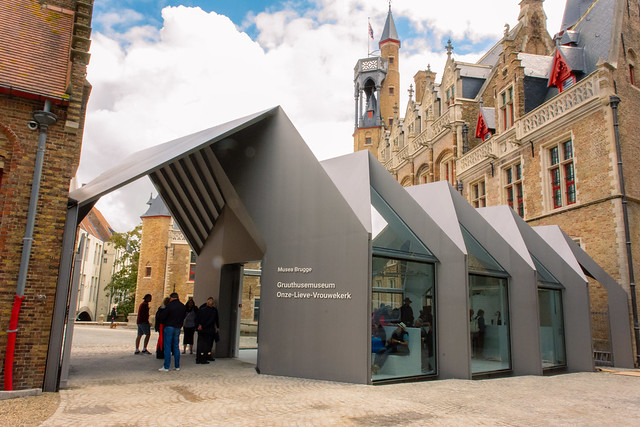- Daily & Weekly newsletters
- Buy & download The Bulletin
- Comment on our articles
Revamped Gruuthuse museum tells a new story about Bruges
Five years after it closed for architectural renovations, the Gruuthuse Museum in Bruges has reopened with a completely new museum installation that includes more exhibition space, extensive accommodations for people with visual and hearing impairments, and an emphasis on the city’s rich history of craftsmanship.
The star of the museum’s collection and a highlight of any visit is the building itself. Originally built in 1425, it was later expanded under Lodewick van Gruuthuse, a high-ranking official at the Burgundian court and one of the richest men in Bruges. In the late 19th century, the centuries-old landmark was thoroughly restored in the Neogothic style by Louis Delacenserie, Bruges’s city architect.
Van Gruuthuse’s personal motto serves as the inspiration and theme of the museum’s approach: “Plus est en vous” – there is more in you. The idea is that every object has layers of meaning and significance for the visitor to discover. Context is conveyed through grouping in thematic galleries, juxtaposition with other objects and explanatory materials such as wall texts and videos.
“That’s the big difference with the museum we had before, that now we present this collection in a story,” says head curator Aleid Hemeryck. “There are different layers in each collection piece – it’s beautiful to see, it has art-historical importance, but we also look at the importance it has for Bruges: the people who made it, the people who owned it.”
Off-limits no longer

With its intricate stonework, decorative roof gables and belvedere tower, the museum is one of the most beautiful sites in Bruges. The recent restoration campaign carried out repairs to the facades, roof and interiors, as well as updating the heating and lighting systems to be more energy-efficient. Parts of the museum that were previously off-limits to visitors have been converted into exhibition space.
One of the few surviving elements of the original palace is the first-floor prayer chapel, which allowed the family to look directly into the adjacent Church of Our Lady. It’s a unique feature that illuminates the privilege and power of the building’s medieval occupants. The chapel received structural repairs and reinforcement and the original wooden panelling was fully restored.
Visitors enter through the impressive, two-storey entrance hall with its multicoloured Neogothic ceiling. From there they proceed to the room on the left, which serves as an introduction to the museum and its collection. A 15th-century portrait of Lodewick van Gruuthuse has pride of place, showing the palace’s former occupant wearing the ornate chain of the Order of the Golden Fleece, his hands clasped in prayer.
Immediately upon entering the first room, visitors encounter a touch station with a model of the palace and other tactile elements for those with impaired vision. Other touch stations are placed throughout the museum. A video guide with sign language interpretation is available, but due to the building’s historic character, the museum is not accessible to wheelchairs.
Bruges through other eyes

Children will also find the touch elements appealing, since they are usually told not to touch anything in a museum. There are more opportunities for both kids and adults to get hands-on – to try on an 18th-century wig, draw a portrait or smell coffee grounds and tea leaves in the gallery devoted to the shipping trade.
The collection is presented thematically and chronologically, with the ground floor devoted to the “golden age” of Bruges in the late medieval period. The first floor shows life in Bruges in the 17th and 18th centuries, while the second floor is dedicated to the 19th-century Gothic Revival in the city.
One of the highlights of the museum is the lace collection, now housed in a large room on the first floor where visitors can view exquisite examples of antique lace next to extant garments and contemporary portraits of people wearing lace. As lace-making was an important industry in Bruges for centuries, the collection fills an important role in illuminating that history for visitors.
For assistant curator Lieven de Visch, this is the most important function of the new museum. “We hope they will look at our city in a different way, because we tell stories about how people made beautiful things in the city at a moment in history,” he says. “We offer them some context and the possibility to look at Bruges with other eyes, eyes focused on craftsmanship in the first place.”
Pimp the palace

The third-floor attic, formerly used as the museum’s storage depot, has been converted into a changing exhibition space called Studio+. It currently houses an art installation created by four artists and a group of local students, who were asked to respond to the museum’s collection and create something new. “Paleisje Pimpen” (Pimp the Palace) is the first of a series of projects intended to foster community involvement in the new museum.
The only major change to the exterior, which has proved controversial, is the addition of a modern ticket office in the central courtyard. Moving the reception area outside allows the interior to be viewed in its historical integrity and improves flow of visitors.
Tickets for both the Gruuthuse Museum and adjacent Church of Our Lady will be sold here, with plans to add ticketing for all of the city museums. In the future, other museum buildings will house educational classrooms, workshops and additional space for temporary exhibitions.
Photos from top © Inge Kinnet I iov Musea Brugge, Inge Kinnet I iov Musea Brugge, Sarah Bauwens/Musea Brugge, Sarah Bauwens



















